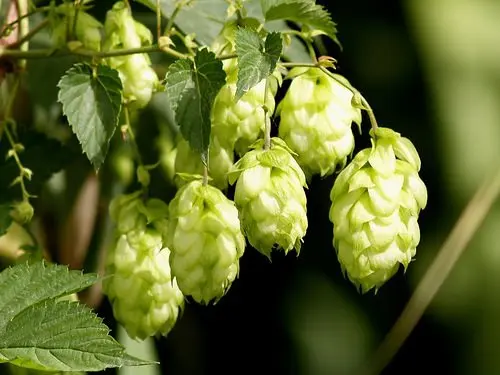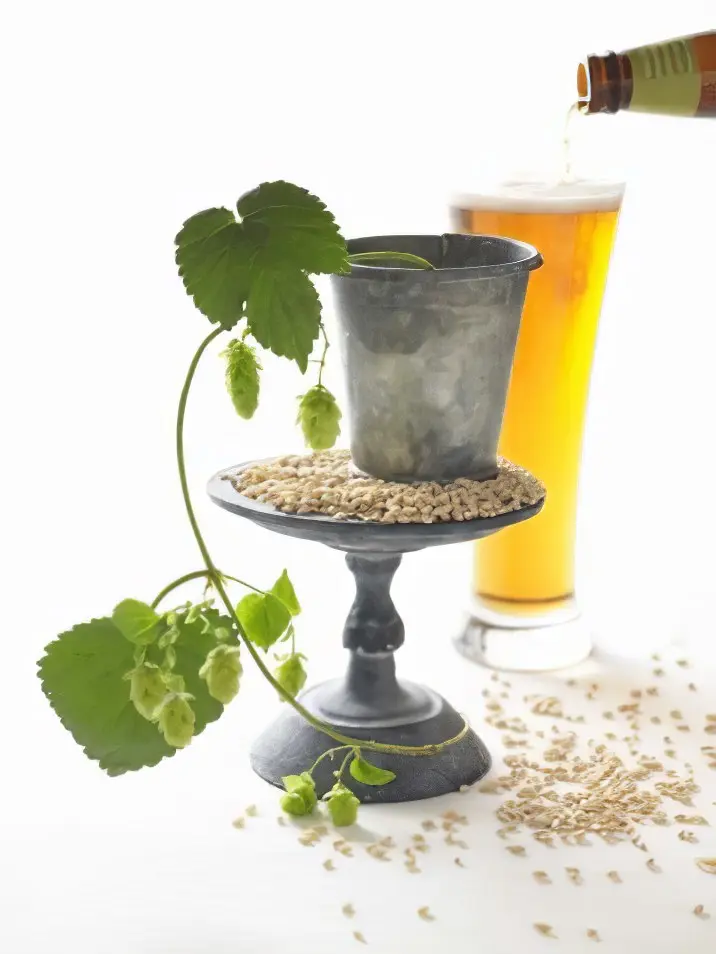Contents
Useful properties, application and cultivation of hops
Botanical characteristics of hops

Hop is a perennial plant with a creeping and long rhizome. The stem of the plant is curly, on its ribs there are sharp spikes in the form of hooks. On hop stems, which can reach 7 meters in length, leaves are located in an opposite position on long petioles. During flowering, same-sex flowers appear, which are located in the axils of the leaves. The fruit of the hop is a brown nut, inside of which there is a seed. The plant blooms from mid-summer to late summer. The fruits ripen in late August – early September.
Hops are found throughout Russia, the Caucasus and Asia. Hop prefers moist fertile soil in the forest, between bushes and along ravines.
Hop cultivation
Hops grow best in partial shade and in places that are protected from the northern winds. The soil for growing hops should be moist and fertile, preferably loamy. In autumn, pits are made for planting plants, into which manure and earth are poured in equal proportions. And in the spring, cuttings or hop seedlings can be planted in prepared pits. Cuttings must be cut from old plants that are at least three years old. Hop seedlings should be at a distance of a meter from each other.
Hops can be propagated in several ways: by seeds, root offspring and division of rhizomes.
Seeds propagate only those varieties of hops that grow one year. In this case, the seeds are simply sown in the spring in the prepared soil.
The division of rhizomes is also carried out in the spring – at the time of the appearance of the first shoots. The division is made with a shovel, but at the same time it is not necessary to dig out a bush.
Cuttings of rhizomes are cut into pieces 15 cm long. Each cutting should have 2-3 pairs of buds. Already cut cuttings of rhizomes must be planted at an angle. If it is not possible to immediately plant the cuttings, then they are covered with moss or wet sand until the day they are planted in the soil.
Hop care is easy. It needs constant weeding, watering and loosening. And in the first years after planting, it is necessary to fertilize the soil, because this contributes to the rapid growth and development of the plant. As you grow, you need to look after the roots of the hops, as they can crawl outside the planting.
Useful properties of hops
Hops contain resins, bitterness, essential oils and flavonoids, which determine the calming effect of hops on the human body. The herb has anti-inflammatory, anticonvulsant and antihelminthic properties. Hops is a plant that improves not only appetite, but also normalizes the digestion process. Hops have analgesic and sedative properties. In addition, it is used as a good laxative and hypnotic. Strange as it may seem, but hops are a means that reduces sexual arousal. In addition, the plant copes well with depression.
Hop application

Hops have long been used in folk medicine, and its main property is a sedative and analgesic. Hops are recommended for gastritis, diseases of the bladder and kidneys, overwork and neuroses. A decoction is prepared from hop flowers, which is used for stomach cancer, lungs and edema. A hop infusion helps in the treatment of colds, dropsy, malaria and visual impairment.
The infusion is also used externally – in the form of compresses, which are applied to bruises, baldness, wrinkles on the face and wounds on the skin. An ointment is prepared from hop cones, which is used for rheumatism, abscesses and neuralgia. A decoction of cones is used externally in the form of baths for insomnia. A pillow filled with hop cones can also help with insomnia. Cones help in the treatment of many other, very different diseases.
Hop oil. To prepare hop oil, take a half-liter glass jar and fill it with hop cones (which were pounded beforehand), then fill them to the top with olive oil. Leave the mixture to infuse, and when the mixture settles, add oil. Place the container with the composition in a dark place for a week. Remember to shake the contents of the jar every day. After straining the finished oil, leave it to stand for 3 days. The oil is ready for use. Most often it is used for rubbing the female breast (for the development of the mammary glands).
A decoction of cones for insomnia. To prepare it, take 1 teaspoon with the top of hop cones and pour them with 100 ml of boiling water, after which we put the mixture for 15 minutes in a warm place. Take the finished decoction twice a day for a calming effect or at night 1 hour before bedtime, 200 ml.
Hop cone tincture. Take 1 tablespoon of hop cones and place them in a glass jar, where pour a glass of vodka or alcohol. Put the jar to brew for 10 days. After insisting, we filter the contents of the jar. This tincture is taken 15 drops (10 drops can be used) three times a day.
A decoction of hop cones is used to give hair shine and splendor, rinsing them after washing.
Contraindications to the use of hops
Hops are absolutely safe for everyone, but if you use it in acceptable doses. Excessive doses of hops will lead to poisoning, the symptoms of which are vomiting, nausea and abdominal pain.









